Saturday night the Eisenhower stage at The Kennedy Center boasted not just one world premiere of an opera, but four, and all pointing to the future of the art form for this century. All were written in English and aimed to tell stories that relate directly to the American experience. Turns out opera is American as apple pie.
Washington National Opera (WNO) has championed new American works and voices in its American Opera Initiative (AOI) series for over ten years. Artistic Director Francesca Zambello envisioned the commissions as a tribute to the Kennedy Center‘s 50th Anniversary and a way of bringing back together some of the family that Zambello holds dear. (See my recent interview with her.)
Zambello assigned a common theme: Washington itself as a city of iconic monuments. She gave the creative teams the freedom to tell a story inspired by a monument of their own choosing.
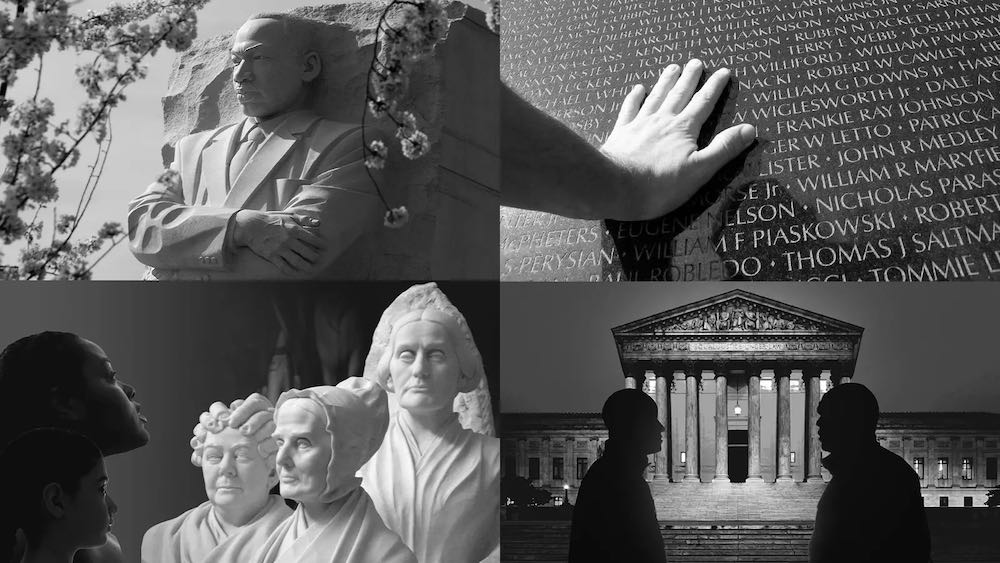
In Washington, history feels scaled like opera, where the stakes are always high and decisions are taken very much to heart. Now we live at the intersection of the crisis of American democracy itself and the current world crisis caused by Russia’s invasion of Ukraine.
It is no wonder then that the most moving moment in the evening came as a prelude to the operas themselves. General Director Timothy O’Leary announced from the stage that several members of the WNO Orchestra are Ukrainian and invited the audience to stand in solidarity. Against a scrim, the sky blue and yellow Ukrainian flag waved, and the orchestra played Ukraine’s national anthem while members of the Cafritz Young Artists Program sang. The stage became a living monument and tribute to people who will not back down from a Russian bully. We were all one in that moment and such an outpouring of feeling, something we all needed as release. This is what music can do.
It seemed fitting that the great American conductor Robert Spano would lead the orchestra for this program, making his WNO debut. He faced the challenge of excavating four different music universes. In doing so with such sensibilities, he earned the respect of the fine returning orchestra members and gave the living composers the opportunity to hear their works fully.
Putting the very different shows on in the Eisenhower together offered other challenges, which the design team met with most creative solutions. While not exactly “intimate,” the Eisenhower stage is certainly smaller than the Opera House but larger than the Terrace, where the AOI programs are usually offered. Placing the orchestra not in the pit but upstage of the singers created not only a better balance of sound but scaled things for smaller chamber-sized ensembles.
With four enormous rectangular frames and a scrim, Set Designer Erhard Rom designed a set that worked for multiple venues featuring different monuments. Rom created giant surfaces that S. Katy Tucker used for projections, choosing photos shot from different angles and in black and white to give the monument giants a unified look through light and shadow. Lighting Designer Mark McCullough added color periodically to affect mood, and the stage pictures were thus elegant and dramatic. Sadly, all too rarely were we given a glimpse of the orchestra, which seemed crammed inside monumental walls.
The first piece up, Chantal, was billed as a prelude, only eight minutes, and a “tribute to Monumentalism” by the husband and wife team Jason and Alicia Hall Moran, who collaborated on the one-woman piece. Director of the Jazz Program Jason Moran is known in the KC family as a most wonderful producer, collaborator, and composer in his own right, and mezzo-soprano, multi-media artist Hall Moran has a gorgeous stage presence. But her sound-making seemed to come from another universe than what goes by the name of classical opera with its rules of vocal placement and focus.
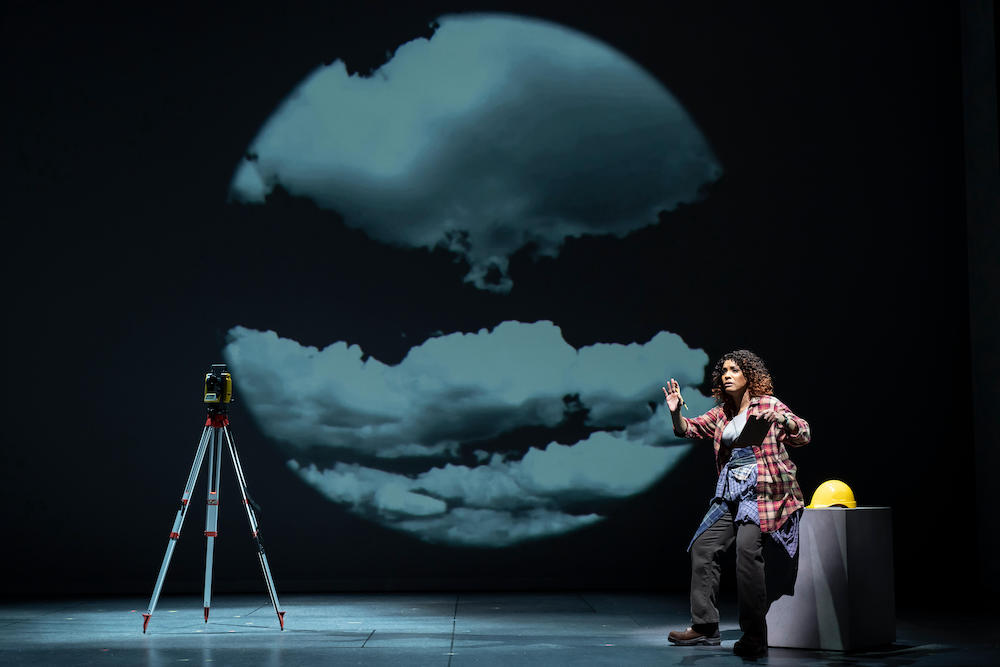
The piece’s message was also a little confusing. We watched a surveyor in flannel work shirt with a hardhat measure the leaning of one of DC’s newest monuments, the statue of MLK. She wonders if their positions have changed, meaning, I supposed, more than physically in space but politically. She ruminates, “A monument is an answer. A monument is a question.” The opera is a koan. The opera is a curiosity.
The evening featured Kamala Sankaram’s second commission by WNO. The first was produced in 2019, a powerful hour-long work, Taking Up Serpents, with librettist Jerry Dye. For this program, Rise, she created with librettist A.M. Homes.
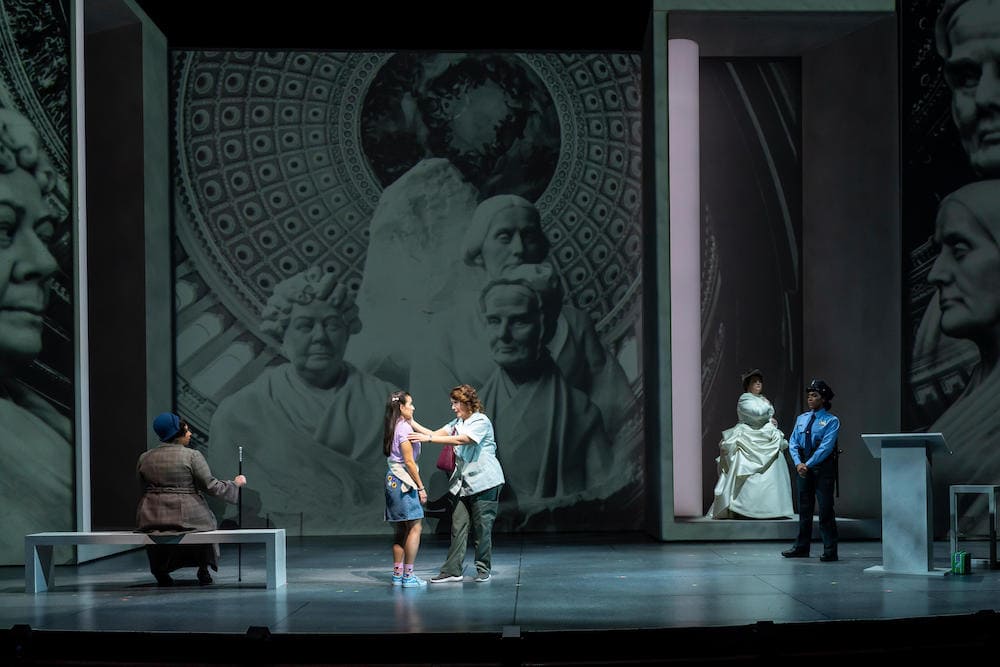
They chose as inspiration the 1921 Portrait Monument by a female sculptor featuring Lucretia Mott, Elizabeth Cady Stanton, and Susan B. Anthony, with an additional face left uncarved. The mysterious suffragist monument, with the story of why it had been junked in a closet for so many years, was tantalizing.
Sankaram and Homes wanted to give a voice to those whose stories have been left out of history. Vanessa Becerra carries the story of a young Girl Scout, Alicia Hernández, who gets lost in the Capitol on a field trip to DC, becomes separated from her troupe, and can’t figure out, looking at the monuments, how she fits into the narrative. Becerra lends charm and comic delight to the role, and she throws off the high piano notes with ease.
The trouble lies in the libretto. Alicia’s journey of self-discovery doesn’t get very deep. The young girl is hoping to “get a badge and a chest” for this outing. There’s a whole scene when she has to circumnavigate a “very powerful woman.” (The figure was supposed to pay tribute to Nancy Pelosi.) Sung by Darryl Freedman, the woman comes across more cartoonish than stately, while, in their scene, Becerra hops and doubles over to suppress bladder urges. The historical lack of bathroom accommodations made for women at the Capitol became a tired running joke.
Sankaram’s score uses marches featuring snare drum to pound in the political message.
One of the best scenes was between the young scout and a security officer. The wonderful J’nai Bridges gives us a strong cameo in the character of the policewoman, and she packs a lot of physical detail and pathos into her portrait, lending the work strength and gravitas. Danielle Talamantes has a lovely voice and intonation and, as Alicia’s mother, also demonstrated emotional connection and verisimilitude, but alas, she wasn’t directed to deliver the same style of performance.
The mixture of styles became confusing. Intending to be a “smart” story, Freedman ranted like a modern Walkurie while Suzannah Waddington looked like a bride figurine on a wedding cake designed by the sculptor Botero, and the resolution made the whole journey of finding oneself trite, while feminism came across as those two hated bywords “shrill” and “silly.”
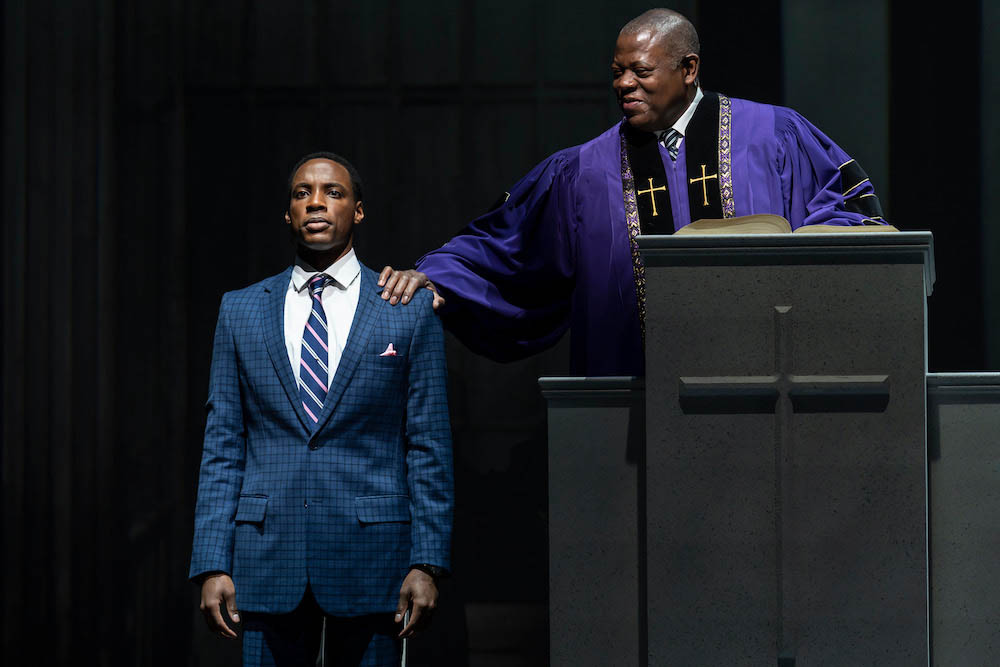
it all falls down was the most fully realized piece of the evening. With a libretto by Kennedy Center‘s Vice President and Artistic Director of Social Impact Marc Bamuthi Joseph and a score by Kennedy Center’s Composer-in-Residence Carlos Simon, the opera from the jumpstart demonstrated we were in the hands of a team who knew how to tell a story with words and music contributing to a satisfying whole. They focused dramatic action on a father and son’s generational rift, and the forward movement musically proved their story satisfied the Three Bears principle of being “just right.”
Christian Mark Gibbs plays Bklyn, the son of a preacher, and his father Mtchll, played by Alfred Walker, takes us into a Black Church community where we watch Mtchll on the day he’ll be passing his preaching in the pulpit to his son.
J’nai Bridges plays Laurel, Mtchll’s wife and mother to Bklyn, torn up by the lie she sees her son living and the father’s inability to recognize and reconcile with his son’s homosexuality. She gives a tour de force performance as a woman full of equal parts grace and pain. Gibbs is phenomenal as Bklyn, a tenor not afraid to pull back, shape, and then build sound and extend notes to forever. Walker makes up this powerful singing trio, and he is arresting as the pastor whose worldview is shaken.
The opera is tip-top in every aspect, from the bodacious “crowns” of the Black women in the church to the powerful, down-to-the-toes earth-shaking voices of the chorus. The opera puts the whole question of how to include people in our understanding of God-love squarely back on us, the audience, to examine the choices before us.
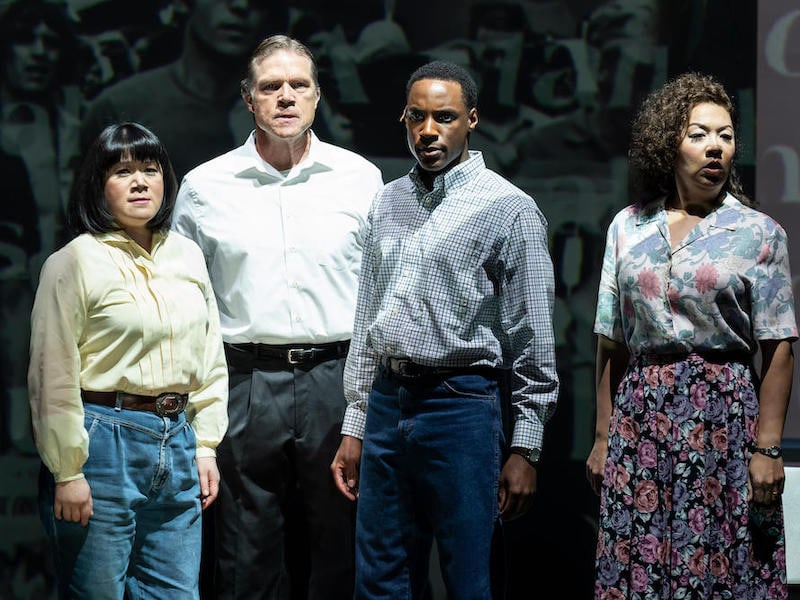
The second half of the program was filled by The Rift, a story told from four different perspectives about the most emotionally-laden monument, The Vietnam War Memorial.
Award-winning composer Huang Ruo and librettist, renowned playwright, and screenwriter David Henry Hwang recount the competition to design the memorial and its surprise winner, who at the time was only a student at Yale. Because submissions were handled anonymously, when it was announced that a young student had won the competition and a girl, and not just a girl, but an Asian girl, reactions were volatile.
Karen Vuong plays Maya Lin, the architecture student, and she is a superb singer-actor. Her arias are some of the best written and performed in the evening. Her performance of “Chinese as Apple Pie” knocked me out.
Hwang’s libretto is risky, expanding the scope of the war story to include many perspectives and force several character changes by the nimble performers. The staging gets necessarily “workshoppy” in that regard, but the writing evokes the times accurately and powerfully. Ruo’s score also has moments of great emotional power, although much seems to come from the composer John Adams’s school of music, including rifts and cadences seemingly taken from his Doctor Atomic opera.
There are four fine performances, though it seems to be dozens of personifications and voices. Rod Gilfry plays Robert McNamara, a different kind of “architect,” and he’s a dead ringer for the man who as Secretary of Defense escalated an unwanted war with the hubris that the U.S. could win only to have even his family turn on him. Gilfry conveys both the arrogant defensiveness and the torment that hounded him for the rest of his days from his role in the war. Nina Yoshida Nelsen takes us into the heart of a South Vietnamese soldier’s widow, who like so many touched by that war kept searching for closure. Christian Mark Gibbs returns in the program as Grady Mitchell, a Vietnam vet who we learn suffers secretly from PTSD. The interweaving of characters, vocal parts, and perspective is brilliantly delivered.
Running Time: Approximately two and a half hours with a 20-minute intermission.
In English with projected English titles
Written in Stone plays to March 25, 2022, in the Eisenhower Theater at the John F. Kennedy Center for the Performing Arts, 2700 F Street NW, Washington, DC. For tickets ($39–$199), call the box office at (202) 467-4600 or toll-free at (800) 444-1324, or purchase online.
The Written in Stone program is online here.
COVID Safety: Proof of full vaccination against COVID-19 and a valid photo ID are required to attend all indoor performances and events at the Kennedy Center. Patrons are asked to wear masks throughout the performance. Further information is online here.
SEE ALSO:
A Q&A with Francesca Zambello on WNO’s new opera, ‘Written in Stone’ (interview with the Kennedy Center artistic director by Susan Galbraith)
‘Written in Stone,’ four monumental mini-operas, debuts at Kennedy Center (review by Michele Simms-Burton)




